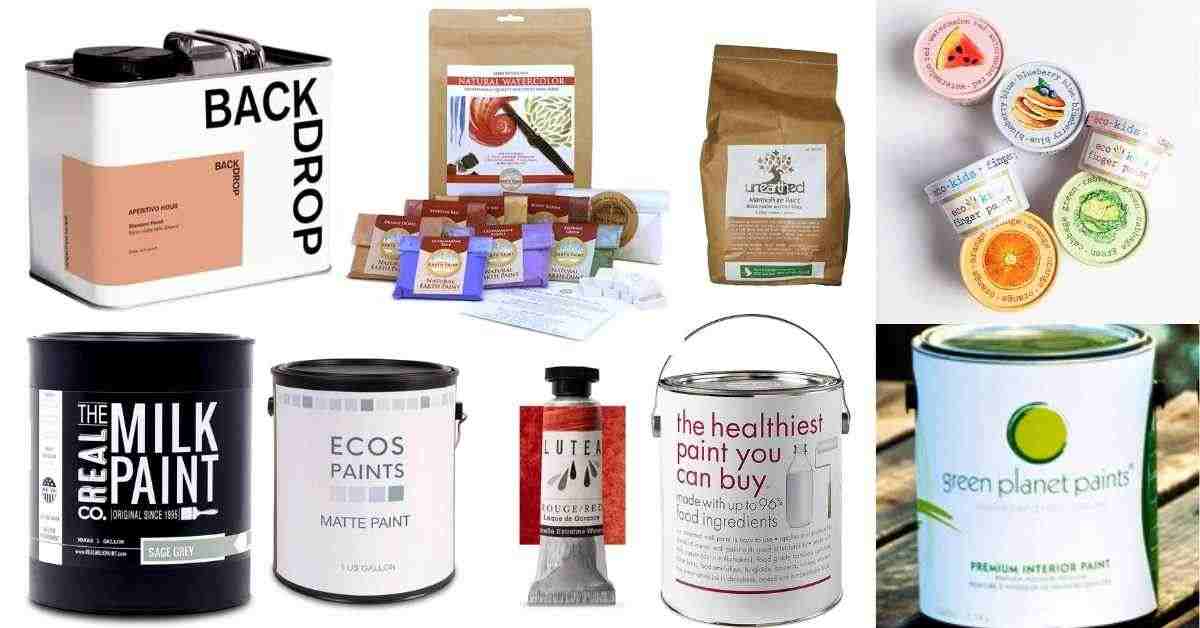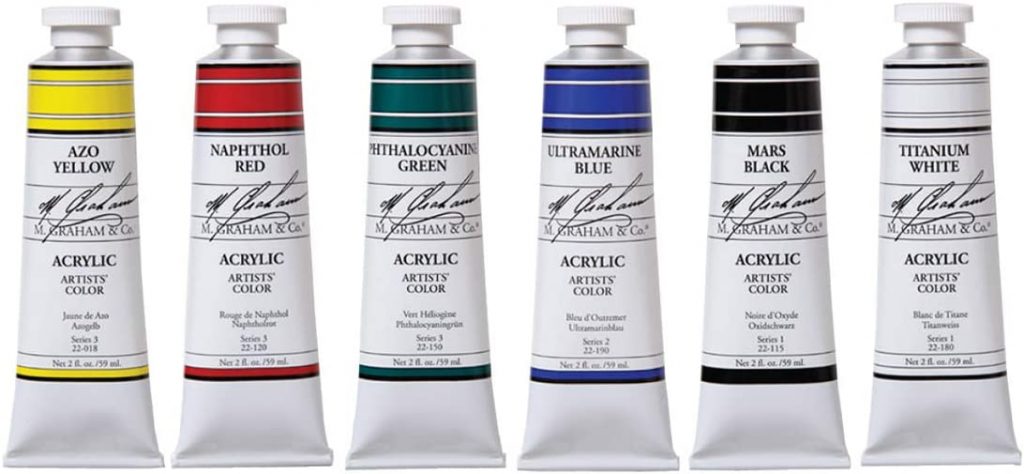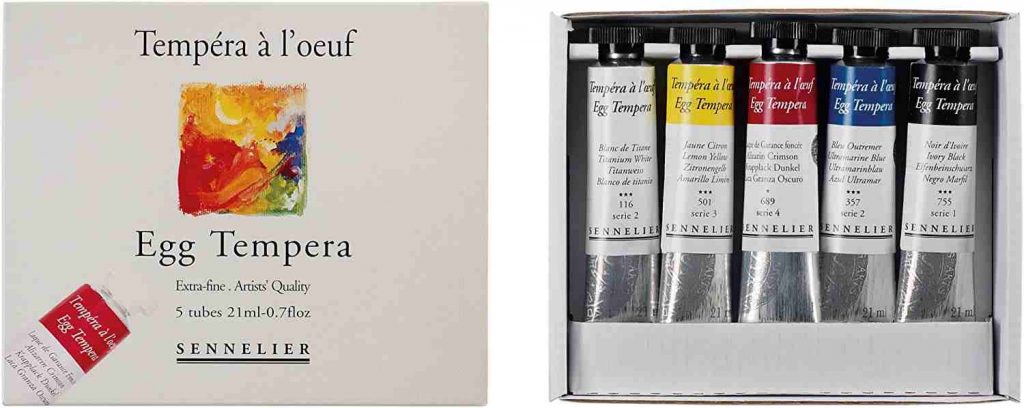Last Updated on March 12, 2024 by Masha Eretnova
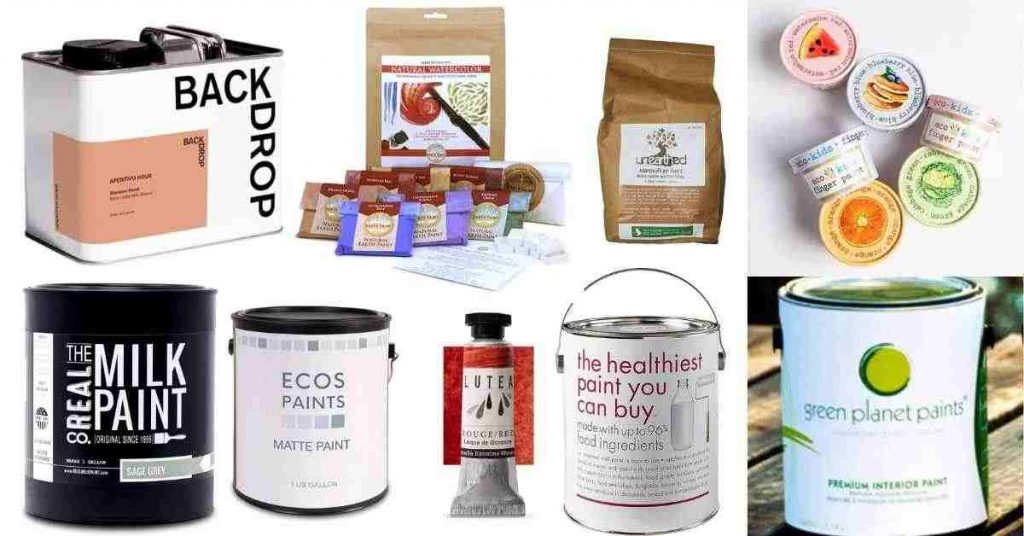
Many artists favor acrylics because they are relatively cheaper, easy to use, and durable. But acrylic paint is not entirely great for your health and the environment.
Fortunately, there are several eco-friendly alternatives to acrylic paint in the market.
Some eco-friendly alternatives to acrylic paint include watercolors, gouache, and tempera. There are also a lot of brands like Placrylic, Natural Earth Paint, The Real Milk Paint Co., and ECOS that offer eco-friendly alternatives for your other different painting needs.
Table of Contents
Read also: Best Acrylic Paint: 20+ Brands Reviewed for Beginners [From Cheap to Pro]
This article contains affiliate links. It means no extra cost for you but a little commission (2-3%) for me to support my hobby and blog. Thank you!
Is acrylic paint toxic and bad for the environment?
Generally, acrylic paint is non-toxic in small amounts. But acrylics are not environment-friendly.
But acrylic paint has toxic products in its pigments (mostly safe amounts) that may have short or long-term effects on your health. Some people report skin or throat irritation when exposed to acrylic paint for long periods of time.
Large amounts of acrylic poured into drains pollute sewage water and affect aquatic life. Gases in acrylic paint, such as benzene, also reduce air quality.
Likewise, most color pigments are also non-biodegradable and, like plastics, take years to decompose.
Paint particles ingested by animals can also go up the food chain and end up on people’s plates.
Some pigments, like Bone Black, may contain carbonized cattle bones.
Read also: Best Edible Markers for Cookies Decoration [Buyers Guide]
Best eco-friendly alternatives to acrylic paint
Here are the best eco-friendly alternatives to acrylic paint, including the best brands and mediums for your house painting and artistic needs.
- Top eco-friendly alternative for home improvement:
- Real Milk Paint Co. is great for furniture
- ECOS Paint is best for walls, exteriors, ceilings, pets dwellings, air purifying paints
- Top eco-friendly art paint:
- Natural Earth Paint for face painting, eco oil paints
- Gouache
- Placrylic
Read on to learn more about these eco-friendly alternatives.
Placrylic – Plant-based paint
Placrylic is a new paint created by an artist Hana who wanted to go green and protect our planet. It is a genius invention – plant-based binder is mixed with plant derived pigments.
None of the colors have any titanium dioxide, plastics or chemicals which means this paint can go down the drain and do no harm for marine life.
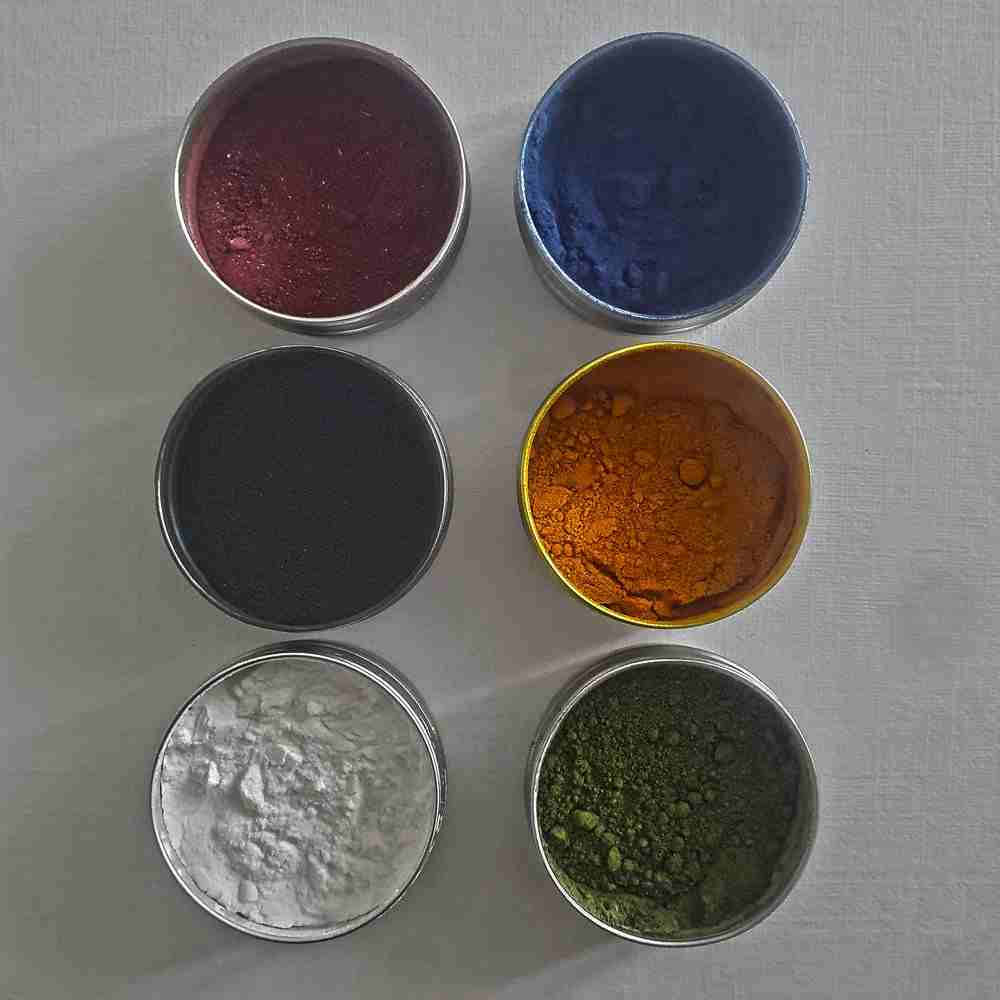
Th actual paint got the best from two paints – it is buttery like oils and fast-dryin like acrylics.
The colors come in powder and you get the binder to so you can easily mix your own paints. They are not cheap but a portion of the sales is sent towards deforestation issue.
Natural Earth Paint – Best eco-friendly alternative for acrylic paints
Green America-certified company Natural Earth Paint features the most eco-friendly alternative for acrylic paints.
Natural Earth Paints use natural ingredients for their paints (some are vegetable based paints), which are non-toxic for your health and planet.
Their paints come in recycled packaging and compostable pigment pouches, so they’re also environmentally friendly.
Since their products are non-toxic, they’re also kid-safe.
In particular, their Natural Earth Paint set is designed for children.
This set features vibrant, tempera-like paints that you can use on wood, paper, glass, and fabric.
They also have face paints, oil paint, watercolor, eco-friendly brushes, gesso, natural varnish, and many more mediums for any type of artist.
| PROS | CONS |
| – non-toxic – reasonably-priced – archival quality – durable – big range of different mediums and supplies for crafts and art | – Non-biodegradable – The color range is limited. – A bit of work to mix it. – Stains clothes. |
Earth Pigments
You can also DIY your paint with Earth Pigments.
They offer dry powder pigments composed of organic, naturally-occurring minerals and are produced in Italy. So they’re guaranteed non-toxic and safer for you.
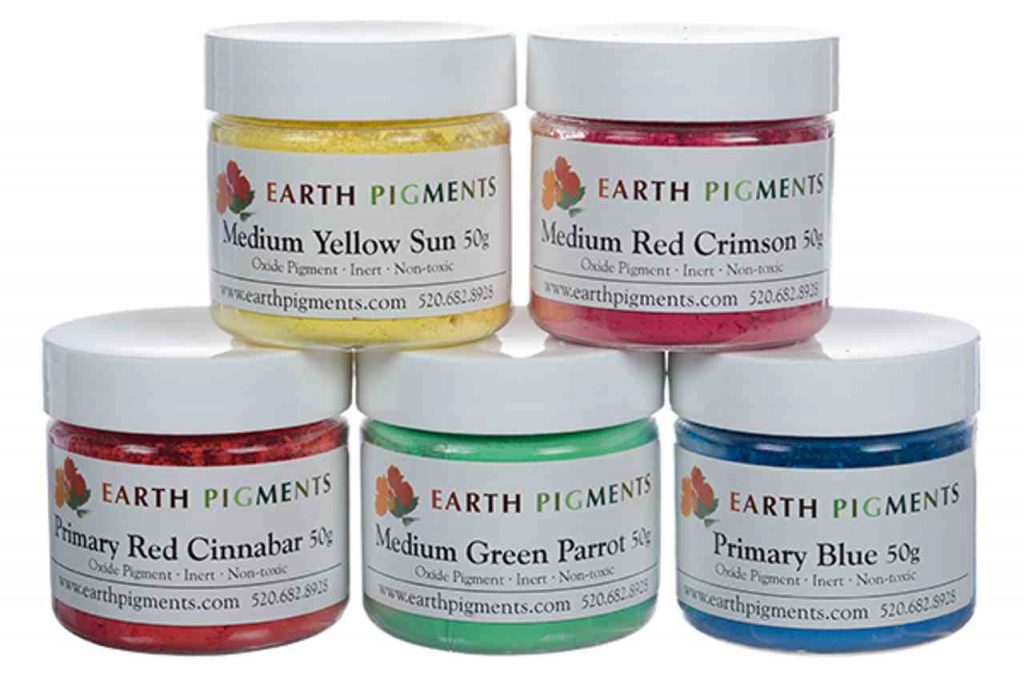
With their earth pigments, you can mix and create:
- Oil paints
- Egg tempera
- Acrylic
- Pastels
- Watercolor
- Gouache
They also have how-to guides on their website to help you mix your own stains, gesso, varnish, and lime wash, among others.
All the materials you need in mixing your non-toxic paint mediums are available on their website.
Not all their pigments are naturally occurring. But they guarantee that their artificial dry powder pigments are also non-toxic.
Their pigments are also slightly expensive compared to premade paints, but a little goes a long way.
| PROS | CONS |
| – non-toxic – Can be used to create a variety of mediums – has a wide range of colors – great value (if bought as a set) | – Some colors are less saturated – Less coverage (when used as pigments alone) – needs to be prep before use – slightly expensive |
Earthesy

Eartheasy is a lifestyle company offering eco-friendly and sustainable living tips and products.
They claim to make a conscious effort to reduce their company’s carbon footprint and overall environmental impact.
In particular, their eco-finger paint set comes sustainably produced from natural fruit and vegetable extracts.
While Eco-Kids Milk Paint is completely biodegradable. They also have crayons and all sorts of craft kits for kids.
Their paints have a limited range of colors, but they’re still great for use with kids.
They’re food-safe, GMO-free, and kid-safe, and you can use them to teach color mixing and painting basics to children.
| PROS | CONS |
| – non-toxic, VOC-free, low odor, no GMO – biodegradable (milk paint) – child-friendly food-safe paint | – a limited range of colors – needs to be prep before use (mix 1:1 with water) |
Let’s move on to regular acrylic paint brands and other mediums that are trying to be more eco-friendly with their production, paints, and packaging.
They may not be yet 100% environmental but they are making a strong effort in it and I think there are worth mentioning.
M. Graham & Co.
M. Graham & Co. is a well-known brand producing premium artist-grade oil paint, acrylics, watercolors, and gouache.
They are environmentally committed to using non-toxic products to clean their equipment and reuse and recycle wastewater.
For ex., M Graham gouache is made with pure blackberry honey and has no opacity enhancers and no chalk.
They also produce solvent-free paints, so they are easier to dispose of. They produce fewer hazardous pollutants, so they have minimal effect on air quality.
This also means they have fewer eye, nose, and throat irritants.
They primarily use walnut oil, which is moderately sustainable for the environment. This is also plant-based and non-toxic.
| PROS | CONS |
| – a wide range of colors and paint mediums, including oils, watercolors, and gouache – environmentally-friendly production process – less toxic than other commercial artist paint brands – solvent-free – low VOC and less odor | – less tolerant of adverse weather changes – increased drying times, depending on humidity or temperature – harder to clean the painted surface – expensive |
Read more: 15 Best Gouache Paint Sets in 2023 For Beginners and Pros
Colourcraft’s Eco Acrylic Paint
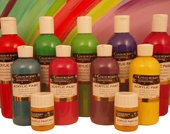
Colourcraft is a UK-based brand, more known for Brusho®, a water-based and non-toxic paint powder.
But they also carry eco-friendly acrylic paint alternatives – Eco Acrylic Paint and Eco Metallic Acrylic Paint.
These soft-bodied paints offer great coverage and become water-resistant once dried. They have a limited color range, but all colors are mixable, so you can easily expand your palette.
They are also lightfast, so your painting will last a long time.
| PROS | CONS |
| – environmentally-friendly production process – non-toxic, solvent-free, VOC-free, wheat and gluten-free – easy to clean up with soap and water | – limited color range – can be expensive and only available on their website |
Egg Tempera
Tempera paint is a water-based paint made traditionally with color pigment, water, and egg.
Nowadays, it uses starch or cellulose binders, making tempera paint non-toxic and safe to use with kids.
Like acrylic, tempera paint dries quickly, making it easy to use.
It is also popular for use with kids because it is completely washable.
This paint is creamy and dries semi-opaque with a matte, chalky finish.
| PROS | CONS |
| – non-toxic and less VOC – quick drying – cheap – easy to use and washable on the skin – kids-friendly | – not lightfast – not applicable for a lot of surfaces works best on paper products only – only dries with a matte finish |
Read also: Tempera Vs Acrylic Paint: What Are The Differences?
Lutea Watercolors
Watercolor is another great alternative to acrylic painting. It comes in a wide range of colors but is more eco-friendly.
It uses natural binders, mostly gum arabic, so it is mostly non-toxic and safe for use with kids.
This medium is also easy to work with, so it is beginner-friendly. It is also great for learning color values, as you can easily change them with how much water you add to your pigment.
There is also less waste when you use watercolors.
Because you can still use the dried paint on your palette by rehydrating it with water.
| PROS | CONS |
| – non-toxic, solvent-free, and VOC-free – odor-free – a wide range of colors – easy to use and clean up – can be cheap (depending on the brand) | – has a chalky finish – not lightfast and durable – only works well on watercolor paper (which is not exactly eco-friendly) – tricky to learn how to work with washes |
The best eco-friendly watercolor brands to watch out for are:
Read also: Watercolor vs Acrylic: 21 Differences Between Acrylic and Watercolor
Gouache
Gouache is often considered a cross between watercolor and acrylic.
It is a water-based medium that shares the consistency of watercolors and the opacity and high pigmentation of acrylics.
This medium comes in a wide range of colors and is relatively cheap compared to oil paint. It is also easily reactivated with water, so you can easily work on your blending skills.
In particular, traditional gouache is eco-friendly because it uses a natural binder – gum arabic, and it is water-based.
So this medium is easy to clean up too.
| PROS | CONS |
| – non-toxic, solvent-free, and VOC-free – odor-free – a wide range of colors – easy to use and clean up – can be cheap (depending on the brand)- reworkable with water | – not lightfast and durable in itself (needs a varnish to increase durability) – not opaque – limited surfaces – has a matte finish only |
Read also: Gouache Vs Acrylic: What’s the Difference, and Which is Best for Beginners?
Oil
Not all Oil paints are eco-friendly mediums in themselves.
What makes it a danger to your health and the environment is the type of oils used, the thinner we use for paint dilution and brush cleaning.
VOC in oil paint is also mostly found in color pigments.
Fortunately, there are organic and eco-friendly alternatives to solvents that can make oil paint a great alternative to acrylic paint. These include:
- linseed oil – non-toxic
- gamsol oil – non-toxic
- lavender spike oil – non-toxic
- safflower oil – non-toxic and biodegradable
| PROS | CONS |
| – less VOC (VOC is mostly present in color pigments) – a wide range of colors – professional medium – Natural Earth oil paints have recyclable bottles. | – doesn’t dry quickly – expensive – needs time to prepare (has to be thinned and thinners aren’t eco-friendly) – odor – needs practice and skills – it is not safe to breathe in even non-toxic powdered pigments. |
The most eco-friendly oil paint brands in the market:
- The Complete Eco-friendly Oil Paint Kit (walnut oil and 100% recyclable bottles)
- M. Graham & Co. Oil Paints (walnut oil but not recyclable package)
- EkoPaints – Swedish house paint brand of oil paints based on linseed oil. No solvents, no plastic,
DIY Paint
Did you know that you can make your own paint with flour, salt, and water?
You can check multiple recipes online that require minimal ingredients, often just water.
Some may also require clay, but this can be easily sourced locally.
You can use plant extracts for colors.
Or you can purchase your pigments from some of the brands listed here or in your local craft store.
However, always check the ingredient list, as some pigments contain toxic substances.
| PROS | CONS |
| – you know exactly what is in your paint – can be non-toxic, solvent-free, and VOC-free – can be less odorous or odor free | – degrades over time (lifespan can be up to 3 years only) – may need to mix several batches depending on your project (i.e., house painting or canvas painting) – also takes time to mix |
Colourcraft Colours
A UK-based brand, Colourcraft Colours are certified green paints that have no VOC, no heavy metals, no animal product.
They use sustainable production and natural ingredient which makes all their paints biodegradable.
ANd the range of products is impressive – not just regular paint, but special paints like fabric paint are available!
Best Biodegradable alternatives to acrylic paint
There are also several biodegradable paints available in the market that are completely safe to use because they are non-toxic and created with naturally-occurring products in the environment.
Biodegradable paints use milk protein (casein), plant oils, and dyes or water, so they are sustainable too. Moreover, they contain zero VOCs.
So they don’t affect air quality.
Biodegradable paint:
- Green Planet Paints (for interiors, ceilings, and exteriors)
- Unearthed Paints (milk paint)
- Lutea Watercolors (for art)
- Anna Sova paints (wall paints)
- Placrylic
Green Planet Paints and Unearthed Paints come in powder form, which is non-toxic in itself. But it can still cause adverse health issues if inhaled.
So it is important to always wear a mask when mixing any paint pigment.
| PROS | CONS |
| – environmentally-friendly production process – non-toxic, solvent-free, and VOC-free. – no biocides in Green Planet Paint (most acrylics use it for mold resistance) – Anna Sova is a food-based wall paint (with casein, food-grade bamboo cellulose, etc) – less odor | – often have a limited color range – can be expensive and hard to buy – Anna Sova now ships only white paint |
Best Eco House Paints Alternatives To Acrylic & Latex Paints
BioShield
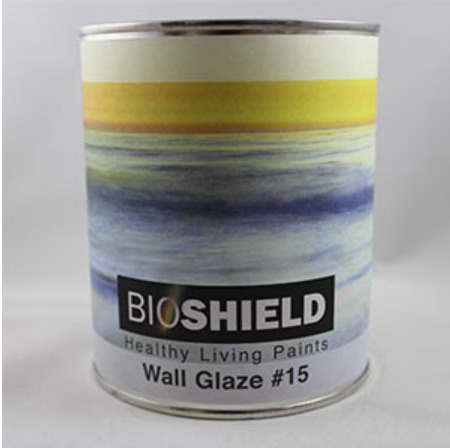
Bioshield markets “healthy living paints” with clay as its primary ingredient.
They use naturally-occurring pigments in their clay paints, so they are less toxic.
Moreover, they are low-odor, so they’re great for people with sensitivities.
Their interior paints dry like lime stucco or clay plasters.
They are also applicable to most interior surfaces and suited for low-impact areas.
They also offer other eco-friendly materials for home improvement, like wood stains, glaze, tints, furniture wax, and thinner.
| PROS | CONS |
| – Less expensive – Easy to use and apply – Self-priming – Durable – Non-toxic, zero VOC, low odor – Non-drip formula – Paint is an antistatic | – Not the best choice for furniture as it doesn’t have abrasion resistance – Limited colors – Not suitable for exteriors and high-impact areas |
Backdrop House Paint
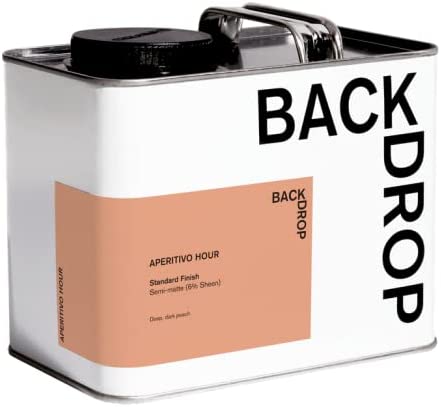
The Backdrop is a Green Wise-certified company producing interior, exterior, and cabinet paints.
This certification ensures that they don’t use toxic products in their paint, so the paint doesn’t contain any formaldehyde, cadmium, lead, or mercury.
Their paints come in a range of colors and semi-matte or semi-gloss finishes. They are also low-VOC and low-odor.
Moreover, the company uses compostable packaging and paint cans made from recyclable stainless steel.
| PROS | CONS |
| – Almost unlimited color choices – Semi-matter and semi-gloss sheen, as well as the dedicated ceiling, cabinet paints, primers, and supplies – Easy to use and apply – Durable, both indoors and outdoors – Non-toxic, low-VOC, and low odor – Super convenient cans to use – 1 gallon covers up to 400 sq f | – Not really budget-friendly |
The Real Milk Paint Co.

Real Milk Paint Co.’s formula is organic, non-toxic, VOC-free, and biodegradable.
Their paints are made from casein, plant-based fillers, lime, and earth pigments.
The lime in this paint acts as a natural mildewcide, reducing mildew growth.
Since their paints are organic and non-toxic, they are also safe for use in homes with pets and children.
| PROS | CONS |
| – You can easily mix to create your own custom colors. – Kid-safe and pet-friendly – Non-toxic, zero VOC, low odor – Works in porous materials like wood and drywall, and in non-porous surfaces (used with binder) – No primer needed! – Blob-free formula | – Not best for concrete surfaces that have a moisture issue – Requires multiple coats – Only comes in matte finish – Dries too quickly – Needs to be mixed before use |
ECOS Paint.

ECOS Paint offers water-based interior and exterior paints, pet dwelling paints, air-purifying paints, primers, stains, and varnishes.
They claim to use non-toxic ingredients, specifically not toxic to your health.
All materials in their products are available for viewing on their website.
Since their paint products are water-based, they are easier to dispose of (compared to oil-based paints).
Also, since they are VOC-free, they don’t degrade air quality in your home.
One of the most versatile, durable, and amazingly made eco paints on the market!
| PROS | CONS |
| – wide color range for interior and exterior paints, big choice of paints for special purposes. – Air-purifying paint improves air quality in the house. – They offer special paint for houses for pets. – Sustainable and durable paint – Non-toxic, zero VOC, odorless – comes in multiple finishes (i.e., matte, eggshell, semi-gloss, and gloss) | – Not budget friendly – Might dry quickly and may result in an unsatisfying uneven surface – May need a primer for best results. |
Lakeland House Paints
Lakeland makes water-based paints free of VOCs, solvents, heavy metals, nothing unsafe. Only natural and organic, tested ingredients.
There is a “fun” video on Youtube where the owner of this brand EATS the paint to prove it is safe. A bit wild, but I guess very solid argument 🙂
Such paints are breathable and safe for houses with little kids and pets.
Are regular acrylics eco-friendly? 22 Brands Explained
Most commercial brands of acrylic paint are not eco-friendly.
Out of 22 acrylic paint brands I checked, only 4 (18%) state that they are eco paints but they don’t disclose the full composition so we cannot prove it. All others are not eco friendly. However, quite a few paint brands are trying to make greener packaging – 7 brands.
However, they are still favored by artists because they are durable.
Unfortunately, what makes it durable are the microplastics that bind the paint and its preservatives and pollute the environment.
Also, in almost all paint types, some color pigments contain harmful ingredients that have short- and long-term effects on your health.
So, what are some eco friendly art paint?
Check out this table for a price and eco-friendliness comparison among common acrylic brands.
| Paint brand | Eco-friendly? |
| Golden Acrylic Paint | Sustainable production |
| Liquitex Basics | No |
| Liquitex Heavy Body Acrylics | No, but they have cadmium-free series |
| Winsor & Newton Acrylic Paint | Sustainable packaging |
| Blick Studio paint | Sustainable product |
| Blick Artists’ paint | Sustainable product |
| Utrecht Artists’ Acrylic Paint | Sustainable product |
| Old Holland New Masters Classic Acrylic Paint | No |
| M. Graham Artists’ Acrylics | Yes |
| Chroma Atelier Interactive Acrylic paint | Sustainable packaging |
| Holbein Acrylics | No |
| Hippie Crafter Acrylic Paint for pouring | No |
| Matisse Acrylics | Yes |
| Daler-Rowney System 3 | No |
| Arteza Acrylic Paint | No |
| Reeves Acrylic Paint | No |
| Grumbacher | No |
| Lascaux Artist Acrylic Paint | No |
| Amsterdam Expert Acrylic Paint | Yes |
| Pebeo Extra-Fine Artist Acrylics | No |
| Acrylic Paint Set by Crafts 4 ALL | No |
| Sennelier Acrylic Paint | No |
| Castle Art Supplies | No |
| Tri-Art Artist Acrylics | Sustainable packaging |
What is the most eco-friendly paint for artists?
The most eco-friendly paints for artists share the following characteristics:
- low to zero VOC (volatile organic compounds)
- biodegradable
- sustainable and eco-friendly
Low VOC content
VOCs preserve the paint and prevent it from getting spoiled. They also make the painting more durable.
However, the presence of these substances is the primary reason paints become non-environmentally friendly. These chemical substances vaporize in the air and reduce air quality.
These substances also have carcinogenic properties and short- and long-term effects on your health, including eye and nose irritation, shortness of breath, and skin problems.
Most commercial paint brands have VOCs, so it is challenging to find paints with low to zero VOCs. But it is not impossible to find them.
An example of interior paint with zero VOC is BioShield’s interior clay paint.
Biodegradable
Biodegradable paints use natural binders like chalk, casein, and lime. These natural components break down easily (compared to synthetic ingredients), making them less toxic to you and the environment.
The Real Milk Paint Co. offers biodegradable paints created from organic milk protein for exterior and interior painting.
Sustainable and eco-friendly
Eco-friendly paints ensure that the process of creating and packaging the paints has minimal to no environmental effects.
These paints use recycled or recyclable packaging and naturally-occurring pigments and paint ingredients.
Some brands that offer eco-friendly paint types include:
For your arts and crafts needs, Natural Earth Paint is a great eco-friendly alternative. They use recycled and compostable packaging and recyclable and sustainable materials in their paints.
Some paints are not VOC-free or biodegradable, but they have eco-friendly practices that minimize their carbon footprint.
For example, Golden adopts a wastewater treatment where they recycle two-thirds of the water they use. While Windsor & Newton does not use cadmium in their beginner-grade Cotman Watercolours.
FAQ
Is water-based acrylic eco-friendly?
No. Water-based acrylic is not eco-friendly.
Nowadays, all acrylic paint is water-soluble, but it uses acrylic polymer as its binding medium. So, it dries like plastic and is not environmentally friendly. Its wastewater also pollutes sewage water.
Water-based acrylic also still has color pigments that are not really toxin-free. These also have a high risk of causing health concerns, especially for people with sensitivities.
Is acrylic biodegradable?
Unfortunately regular acrylic paint isn’t biodegradable. Once it dries it forms a plastic film that will take hundreds of years to decompose at a landfill.
Conclusion
Art is not always an environmentally-friendly habit.
But we can make a conscious effort to reduce our footprint on the planet.
Check out the products I shared with you in this post, enjoy art and put colors on walls and canvasses that are eco-friendly and sustainable.
Please leave a comment if you know a better alternative and do you think is the best eco friendly paint?

Masha Eretnova, born in 1991, is a Buenos Aires-based certified teacher, artist, and member of the Professional Artist Association with 20+ years of personal painting journey.
She started painting and drawing very early and is now an international abstract artist and educator passionate about acrylic painting, gouache, and crafts.
Her works are part of international exhibitions and contests, including ArtlyMix (Brazil), Al-Tiba 9 (Spain), Exhibizone (Canada), Italy, and many more.
Besides her artistic pursuits, Masha holds a post-grad diploma in Teaching Film Photography and 2 music school diplomas: piano and opera singing.
Last update on 2024-07-27 / Affiliate links / Images from Amazon Product Advertising API
